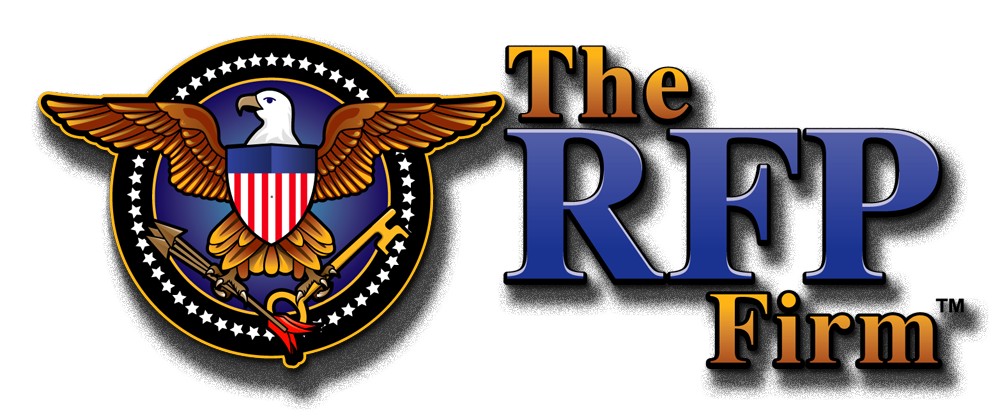Blog
Government & Commercial Proposal Writing Services
 The RFP Firm is expert at writing proposals in Response to Federal and State Government RFP Solicitations that will give you a Competitive Advantage over your competition.
The RFP Firm is expert at writing proposals in Response to Federal and State Government RFP Solicitations that will give you a Competitive Advantage over your competition.


Proposal Writing Services , RFP Proposal Consulting, Government RFP writing
Government RFP Proposal Writing Services
Government & Commercial Proposal Writing Services
 The RFP Firm is expert at writing proposals in Response to Federal and State Government RFP Solicitations that will give you a Competitive Advantage over your competition.
The RFP Firm is expert at writing proposals in Response to Federal and State Government RFP Solicitations that will give you a Competitive Advantage over your competition.

When the government looks to purchase supplies or services, it seeks them from qualified commercial vendors who respond to RFPs (Request for Proposal) by proposal writing in an effort to win those government contracts. This is the case at all levels of government in the United States, i.e., U.S. Federal, state, and local government agencies. In each case, these agencies follow specific procedures to develop their RFPs and vendors must respond in kind to the exact requirements laid out in those solicitations.
When the federal government prepares an RFP, their solicitations must conform to the FAR (Federal Acquisition Regulation) requirements when making purchases. These regulations are intended to standardize the process used by these agencies when issuing RFPs. The FAR requirements define procedures for every step of the process. Even so, within FAR there are many variables that allow for the accommodation of numerous methods, for example there are different contracting methods including negotiated contracts, consolidated purchasing vehicles, sealed bids, and simplified acquisition procedures.
Government contractors find that contracting with the government brings them several advantages. One is that for small businesses, there are often specific set-asides that require the vendor to be certified as a small business enterprise (SBE) or one of several other classifications (Minority-owned business, Women-owned business, Veteran-owned business, Disabled veteran-owned business, HUBZone, etc.). Even when the solicitation is not a 100% set-aside for one of these categories, each contract has goals for subcontracting a portion of the contract to one or more of these categories.
Other benefits include getting paid at regular intervals without risk. Contracts typically last for one to five years thereby providing a steady cash flow during that period. The experience gained by working on these contracts can raise the credibility of the company when pursuing other types of contracts whether for a state, city, or county government or even commercial enterprise. In addition, over time you can continuously expand your business and build on larger and larger contract opportunities over time.
When considered a business, the U.S. Government is the largest in the world. For example, around $1 Billion of service sector opportunities become available to bid on each day by commercial enterprises (small and medium sized businesses). And the variety of products and services covers just about everything from janitorial services and maintaining buildings to new technologies and space flight systems.
State, City, and County governments are also great opportunities for small businesses who offer products and services to the commercial sector. While many small businesses don’t understand how to get these types of opportunities others are taking advantage by gaining an understanding of the state and local government procurement process. This is where proposal writing for government contracts can be of great help in getting into this field. Those who know how to develop successful bids can turn these opportunities into profitable revenue streams for their business. Of course, many of these local contracts are for smaller amounts, but still profitable, these smaller contracts often don’t require the complexity of the larger dollar bids. For example, under a blanket purchase agreement, once approved, you are eligible to bid on small task orders on an ongoing basis without submitting a proposal for each purchase.
There are many different types of firms that support small businesses in their efforts to get into this field. Some are subscription-based services that go out and identify government contract opportunities at all levels and for all services and then send you notices when new RFPs are issued for the services you provide based on specific key words that you have provided. You still have to sort through these announcements, but since there are thousands of website locations to look at, when you take into account the various federal government locations, all of the different state, city, and county website, this can save a huge amount of time.
Once you have identified a specific RFP that you want to respond to, that’s when companies like The RFP Firm can help you put together a 100% compliant, persuasive, and high-quality proposal.
Another prerequisite to have in place before jumping right into proposal writing for government contracts is to get registered with those government entities that require pre-vetting through their registration process before they will do business with your firm as a potential vendor. Since each agency tends to do this their own way, be sure to understand those requirements and start the registration process prior to searching for RFPs to respond to.
One place to help you get started is the U.S. Small Business Administration, Office of Government Contracting and Business Development. They have a workbook that can help provide guidance when preparing proposals in response to RFPs. They will discuss how to acquire several certifications including as an 8(a) business, HUBZone, Woman-Owned Small Business, Economically Disadvantages Small Business, Veteran-Owned Small Business, etc.
Other basic requirements include identifying your North American Industry Classification System (NAICS) definitions for your business. You’ll also need a Dun & Bradstreet (DUNS) Number, and a Commercial and Government Entity (CAGE) Code. The government’s contract database, System for Award Management (SAM) is where contractors can search federal procurement opportunities and where government agencies can learn about prospective vendors. Prior to proposal writing government contracts, registration in SAM is a requirement for becoming a federal government contractor.